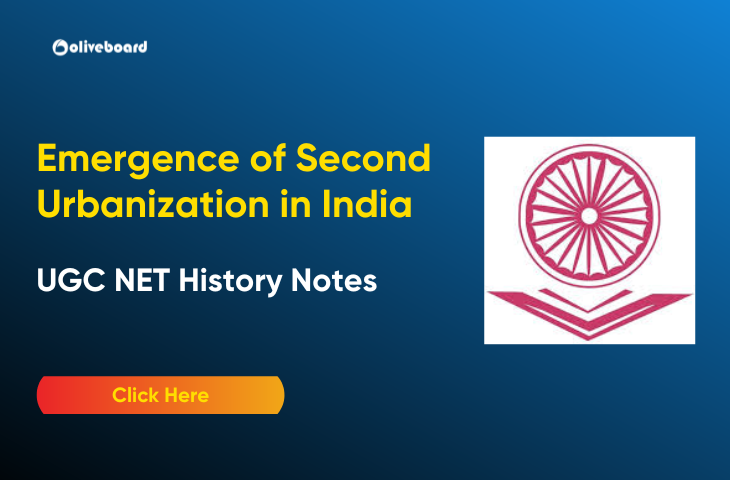The Emergence of Second Urbanization in India, occurring around the 6th century BCE, represents a transformative phase in ancient Indian history, marked by the rise of urban centers after the decline of the Indus Valley Civilization. Centered primarily in the Gangetic Plains, this period was driven by the widespread use of iron technology, surplus agricultural production, and expanding trade networks. It witnessed the growth of Mahajanapadas (large kingdoms) and significant socio-economic transformations, including the rise of Magadha as a dominant power and the emergence of religious movements like Buddhism and Jainism. This phase is essential for understanding the development of urban life, structured political systems, and cultural shifts that shaped early Indian society, making it a crucial topic for UGC NET History preparation.
Click Here to Check UGC NET Notification 2024
Defining Second Urbanization of India
- The Second Urbanization occurred around the 6th century BCE in the Gangetic Plains, following the decline of the Indus Valley Civilization.
- It was driven by the use of iron tools and technology, which enhanced agricultural productivity and surplus.
- The period saw the rise of Janapadas (smaller kingdoms) and Mahajanapadas (larger kingdoms) with organized political systems.
- Urban centers like Rajagriha, Kaushambi, and Shravasti emerged as trade, governance, and cultural hubs.
- This phase marked significant socio-economic, political, and cultural advancements in ancient Indian history.
Decline of First Urbanization of India
- The decline of first urbanization occurred around 1900 BCE to 1300 BCE, marking the end of the mature phase of the Indus Valley Civilization.
- Reasons for the decline of first urbanization:
- Climate Change
- Natural Disasters: Floods, earthquakes, and other natural calamities
- Collapse of trade networks, especially with Mesopotamia, weakened the economy.
- Urban Decay
- Migration
- Socio-Political Changes
- Invasion Hypothesis: Some scholars suggest external invasions, such as by the Aryans, but this theory remains debated.
- Despite the decline, many cultural elements persisted and influenced later civilizations in the Indian subcontinent.
Factors Contributing to Second Urbanization of India
Various factors contributed to the emergence of second urbanization:
- Iron Technology: The discovery and use of iron tools improved agricultural efficiency and expanded arable land.
- Agricultural Surplus: Increased food production supported larger populations and freed some people to engage in trade, crafts, and governance.
- Geographical Advantage: The Gangetic Plains offered fertile soil, ample water resources, and a conducive environment for settlement and farming.
- Rise of Mahajanapadas: Stable and organized political entities provided security and governance, enabling urban development.
- Trade and Commerce: Flourishing internal and external trade networks boosted economic activity and encouraged the growth of market towns.
- Population Growth: Better food security and resources supported higher population density, driving urban expansion.
- Economic Diversification: Specialization in crafts, industries, and professions fostered urban economies and social complexity.
- Religious and Cultural Centers: Cities became hubs for emerging religions like Buddhism and Jainism, which attracted scholars, pilgrims, and traders.
- Technological Advancements: Improvements in construction, irrigation, and transport infrastructure facilitated the establishment of urban centers.
- Decline of Tribal Systems: Transition from tribal to structured societies allowed for the organization of resources, taxation, and urban planning.
Key Features of Second Urbanization of India
1. Emergence of Cities
- Urban centers such as Rajagriha, Kaushambi, Shravasti, and Vaishali became hubs of trade, administration, and culture.
2. Development of Mahajanapadas
- The rise of 16 Mahajanapadas (large kingdoms) like Magadha, Kosala, and Vatsa provided political stability and urban governance.
3. Iron Technology
- Widespread use of iron tools and weapons revolutionized agriculture, construction, and warfare, supporting urban growth.
4. Economic Prosperity
- Cities became centers for trade and commerce, with guilds of merchants and artisans managing economic activities.
- Example: Trade routes connecting cities like Pataliputra with distant regions.
5. Specialization and Craft Production
- Professions like pottery, weaving, and metallurgy flourished.
- Example: Northern Black Polished Ware (NBPW) became a hallmark of this period.
6. Religious and Intellectual Growth
- Urban areas became centers of learning and religious activity, witnessing the rise of Buddhism and Jainism.
- Example: Gautama Buddha delivered sermons in cities like Sarnath.
7. Social Stratification
- The Varna system and emerging guilds defined social roles and economic hierarchy in urban areas.
8. Taxation and Revenue Systems
- Organized states implemented taxation systems, collecting revenue to sustain urban administration and armies.
- Example: Magadha’s efficient revenue policies.
9. Urban Infrastructure
- Planned streets, granaries, marketplaces, and fortifications were characteristic of these cities.
- Example: Rajagriha had fortified settlements.
10. Cultural Exchange
- Urban centers served as melting pots for ideas, art, and culture due to diverse populations and extensive trade.
Impact of Second Urbanization of India
1. Economic Transformation:
- The growth of cities like Pataliputra and Rajagriha fostered the rise of trade, agriculture, and crafts.
- Magadha became a significant economic hub, benefiting from trade routes linking the Gangetic Plains with the Deccan Plateau and Central Asia.
2. Political Consolidation:
- Powerful Mahajanapadas, such as Magadha, consolidated power and resources.
- Magadha’s dominance eventually led to the formation of the Maurya Empire, with Chandragupta Maurya establishing a strong central administration.
3. Religious Movements:
- Urban centers became centers for Buddhism and Jainism.
- Cities like Sarnath (where Buddha gave his first sermon) and Vaishali (birthplace of Mahavira) were key locations for the spread of these religions, challenging Vedic traditions and offering alternative spiritual paths.
4. Cultural Development:
- The urbanization period saw advancements in art and architecture.
- Cities like Kaushambi and Rajagriha developed planned urban layouts, with structures like granaries and fortifications.
- The Northern Black Polished Ware (NBPW) became a symbol of this period’s cultural sophistication.
5. Social Changes:
- The rise of cities led to social stratification, where distinct social classes emerged.
- In Magadha, a hierarchical society evolved, with merchants, artisans, and warriors gaining prominence.
6. Spread of Literacy:
- The use of scripts like Brahmi and Kharosthi became more widespread, especially in urban centers such as Pataliputra and Taxila, to facilitate administration, record-keeping, and communication in trade and governance.
7. Trade Expansion:
- Cities like Ujjain and Pataliputra became major trade hubs, facilitating the exchange of goods such as spices, silk, and textiles.
- Ujjain’s position on the north-south trade route connected the Deccan with the northern regions, enhancing commerce.
8. Foundation for Empires:
- The urbanization of regions like Magadha set the stage for the establishment of the Maurya Empire, with Ashoka’s administration benefiting from the resources and governance systems that arose during the Second Urbanization.
9. Cultural Exchange:
- The rise of urban centers also led to cross-cultural exchanges, with cities like Taxila serving as centers for the interaction of Greek, Persian, and Indian cultures, especially during the time of Alexander the Great’s invasion and its aftermath.
Second Urbanization of India Conclusion
The Second Urbanization of India, emerging around the 6th century BCE, was a transformative period that reshaped the political, economic, and cultural landscape of ancient India. Driven by the development of iron technology, surplus agricultural production, and the rise of Mahajanapadas, this phase saw the establishment of thriving urban centers like Rajagriha, Pataliputra, and Kaushambi, which became hubs for trade, governance, and cultural exchange. The era also witnessed the rise of major religious movements like Buddhism and Jainism, along with advancements in art, architecture, and social organization. The Second Urbanization laid the foundations for India’s later political structures, including the Maurya Empire, and marked a critical turning point in the evolution of urban civilization in the subcontinent.
UGC NET MCQ based on Second Urbanization of India
Q1. Which of the following factors was most significant in facilitating the rise of urban centers during the Second Urbanization (6th century BCE) in India?
A) The decline of the Indus Valley Civilization
B) The widespread use of iron technology leading to agricultural surplus
C) The invasion of the Aryans
D) The establishment of Mauryan Empire
Ans: B) The widespread use of iron technology leading to agricultural surplus
Q2. The development of which of the following during the Second Urbanization was most influenced by the growth of urban trade?
A) Brahmi script
B) Buddhism
C) Northern Black Polished Ware (NBPW)
D) Mauryan administration
Ans: C) Northern Black Polished Ware (NBPW)
Q3. Which of the following statements about the Second Urbanization in India is true?
A) It marked the collapse of urban centers and a return to tribal societies.
B) It was marked by the emergence of urban centers with structured political organizations like the Mahajanapadas.
C) It occurred during the Gupta Empire.
D) It was primarily driven by the growth of maritime trade.
Ans: B) It was marked by the emergence of urban centers with structured political organizations like the Mahajanapadas.
Ans: The Second Urbanization refers to the resurgence of urban centers around the 6th century BCE in the Gangetic Plains, driven by technological advancements, agricultural surplus, and the rise of political entities like the Mahajanapadas.
Ans: Key factors include the use of iron technology, improved agriculture, growth of trade networks, and the establishment of Mahajanapadas (large kingdoms), which provided political stability and resources for urban growth.
Ans: Prominent cities included Rajagriha, Pataliputra, Kaushambi, Sarnath, and Vaishali, all of which became important centers of trade, governance, and culture.
Ans: The development of trade networks facilitated economic prosperity, with cities like Pataliputra and Ujjain serving as major commercial hubs. Goods like spices, textiles, and metals were exchanged, fostering urban growth.

Hello there! I’m a dedicated Government Job aspirant turned passionate writer & content marketer. My blogs are a one-stop destination for accurate and comprehensive information on exams like Regulatory Bodies, Banking, SSC, State PSCs, and more. I’m on a mission to provide you with all the details you need, conveniently in one place. When I’m not writing and marketing, you’ll find me happily experimenting in the kitchen, cooking up delightful treats. Join me on this journey of knowledge and flavors!
